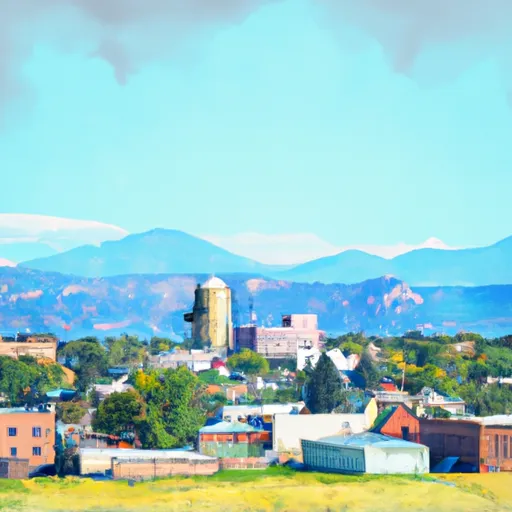-
 Snoflo Premium
Snoflo Premium
Get unlimited access to all our content
With no Ad interruptions! - Start Your Free Trial Login with existing account
Sanford
Eden Index
Climate
6.7
•
Recreation
5.0
•
Community
•
Safeguard
4.4/10

Sanford, Colorado, is a small rural town located in Conejos County. It enjoys a semi-arid climate characterized by mild winters and warm summers. The average high temperature in summer is around 90°F (32°C), while winter temperatures can dip to 20°F (-6°C). Precipitation is limited, with an average annual rainfall of about 11 inches (28 cm), mainly occurring during summer monsoons.
The town is surrounded by stunning natural landscapes, including the nearby San Luis Valley. This region boasts a unique hydrology, with the Rio Grande River running through it, offering excellent opportunities for outdoor recreation. Fishing enthusiasts can try their luck in the river, known for its trout population. Additionally, the Rio Grande National Forest, located nearby, provides ample opportunities for hiking, camping, and wildlife viewing.
Sanford is also close to the Great Sand Dunes National Park and Preserve, where visitors can marvel at North America's tallest sand dunes. With diverse ecosystems, including wetlands, grasslands, and forests, the park is a haven for outdoor enthusiasts seeking hiking, sandboarding, and stargazing experiences.
Overall, Sanford, Colorado, offers a pleasant climate, diverse hydrology, and a wide range of outdoor recreation opportunities for residents and visitors alike.
What is the Eden Index?
The Snoflo Eden Index serves as a comprehensive rating system for regions, evaluating their desirability through a holistic assessment of climate health, outdoor recreation opportunities, and natural disaster risk, acknowledging the profound impact of these factors on livability and well-being.
Climate Health Indicator (CHI): 6.7
Sanford receives approximately
240mm of rain per year,
with humidity levels near 69%
and air temperatures averaging around
6°C.
Sanford has a plant hardyness factor of
5, meaning
plants and agriculture in this region thrive during a short period during spring and early summer. Most
plants will die off during the colder winter months.
By considering the ideal temperature range, reliable water supplies, clean air, and stable seasonal rain or snowpacks, the Climate Health Indicator (CHI) underscores the significance of a healthy climate as the foundation for quality living.
A healthy climate is paramount for ensuring a high quality of life and livability in a region, fostering both physical well-being and environmental harmony. This can be characterized by ideal temperatures, reliable access to water supplies, clean air, and consistent seasonal rain or snowpacks.
Weather Forecast
Streamflow Conditions
Rio Grande Headwaters
Area Rivers
Rio Grande Headwaters
Snowpack Depths
Rio Grande Headwaters
Reservoir Storage Capacity
Rio Grande Headwaters
Groundwater Levels
Recreational Opportunity Index (ROI): 5.0
The Recreational Opportunity Index (ROI) recognizes the value of outdoor recreational options, such as parks, hiking trails, camping sites, and fishing spots, while acknowledging that climate plays a pivotal role in ensuring the comfort and consistency of these experiences.
Access to outdoor recreational opportunities, encompassing activities such as parks, hiking, camping, and fishing, is crucial for overall well-being, and the climate plays a pivotal role in enabling and enhancing these experiences, ensuring that individuals can engage in nature-based activities comfortably and consistently.
Camping Areas
| Campground | Campsites | Reservations | Toilets | Showers | Elevation |
|---|---|---|---|---|---|
| Montoso - Wild Rivers Rec Area | None | 7,500 ft | |||
| El Aguaje - Wild Rivers Rec Area | None | 7,467 ft | |||
| Little Arsenic Springs | None | 7,498 ft | |||
| Cuchillo | 3 | 8,208 ft | |||
| La Junta - Wild Rivers Rec Area | None | 7,465 ft | |||
| North Crestone Creek | 13 | 8,474 ft | |||
| Lower Hondo | 4 | 7,880 ft | |||
| Goat Hill | 6 | 7,682 ft | |||
| Big Arsenic Springs - Wild Rivers Rec Area | None | 7,516 ft | |||
| Cebolla Mesa | 5 | 7,372 ft |
Nearby Ski Areas
Catastrophe Safeguard Index (CSI):
The Catastrophe Safeguard Index (CSI) recognizes that natural disaster risk, encompassing floods, fires, hurricanes, and tornadoes, can drastically affect safety and the overall appeal of an area.
The level of natural disaster risk in a region significantly affects safety and the overall livability, with climate change amplifying these risks by potentially increasing the frequency and intensity of events like floods, fires, hurricanes, and tornadoes, thereby posing substantial challenges to community resilience and well-being.
Community Resilience Indicator (CRI):
The Community Resilience Indicator (CRI) recognizes that education, healthcare, and socioeconomics are crucial to the well-being of a region. The CRI acknowledges the profound impact of these elements on residents' overall quality of life. By evaluating educational resources, healthcare accessibility, and economic inclusivity, the index captures the essential aspects that contribute to a thriving community, fostering resident satisfaction, equity, and social cohesion.

